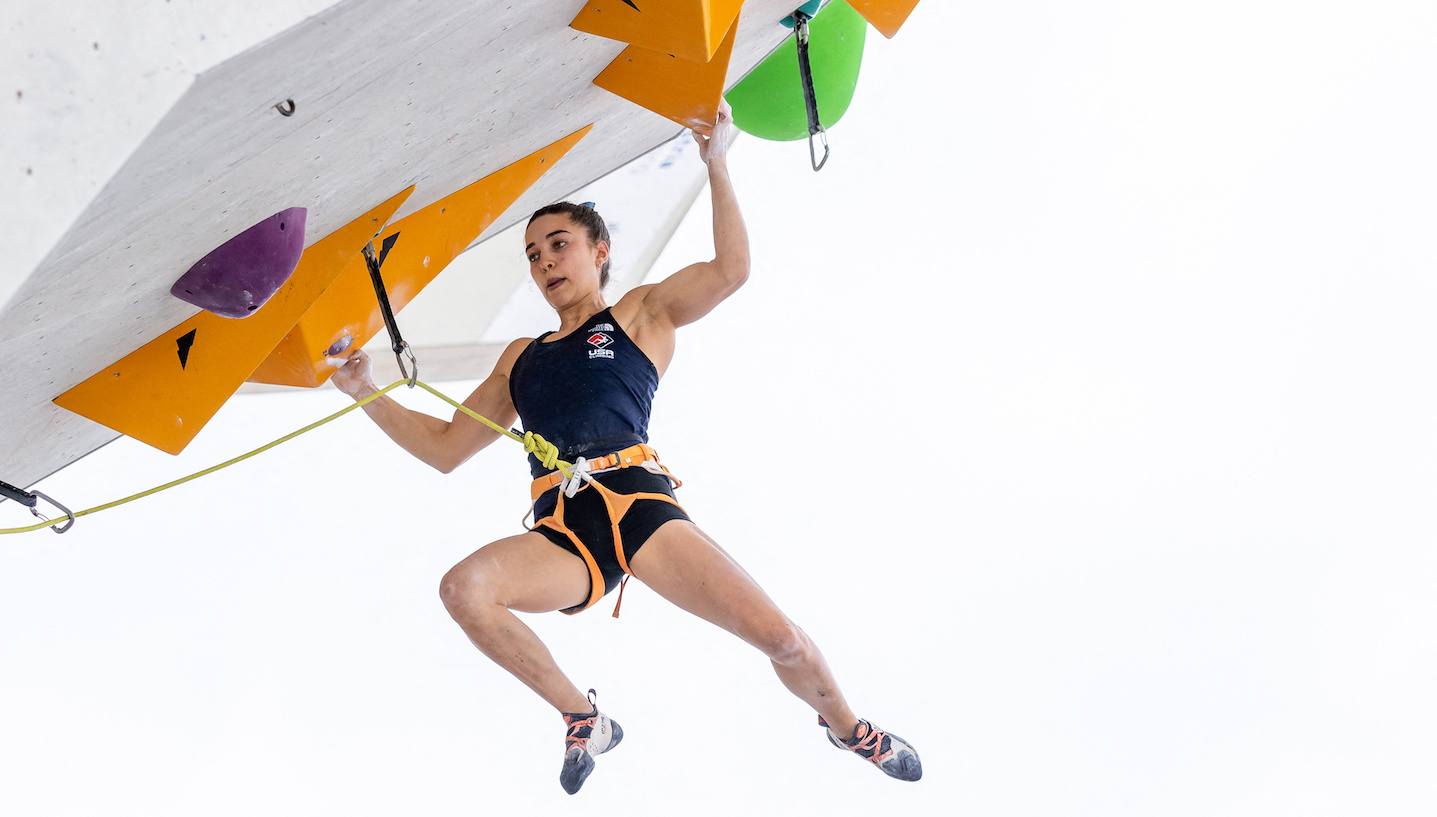Climbing is similar to fellow new Olympic sports surfing and skateboarding in that it began as an outdoor, non-competitive culture, and the competition aspect only really started to take off in the last few decades. The first climbing competition took place in 1985 and it’s been growing ever since. There’s just one gold medal per gender in sport climbing’s Olympic debut, but the IOC has already announced they’ll double the number of medals for Paris 2024 and increase the number of athletes.
How it works: Gold medals for men and women will go to the climber that finishes with the best combined score over three disciplines: Speed, lead, and bouldering.
Lead and bouldering are what you think of when you picture traditional rock climbing in a gym. A climber tries to solve as many puzzles as they can along the rock wall and progress the farthest on the course. In bouldering, there are three or four individual boulders, also called problems and in lead, there is one course, referred to as a route.
“In both bouldering and lead, what you want is to top things, which would mean to finish,” said Meagan Martin, NBC’s climbing analyst for Tokyo.
In bouldering, climbers have no safety gear and have to work through as many problems as they can on a 4.5-meter wall (unique to each competition) in a four-minute time limit. This climbing is closer to the ground and takes climbers across a series of obstacles. If they fall off, they can try again as many times as they want, within the time window. The climber who tops the most boulders wins, and climbers can also gain points from completing zone holds, or getting halfway through a problem.
In lead, climbers clip in and out of marked points and have six minutes to get as high as they can on the 15-meter course. Climbers only have one shot. If they miss a hold, their last completed hold is their final score. There are usually between 36–45 moves on each lead route, which is unique to each competition. The climber who reaches the highest point in the least amount of time wins.
“I like to explain the difference between bouldering and lead as if you were to compare it to sprinting and distance running,” Martin said. “Bouldering is a more powerful discipline. It is not as many moves, it is shorter. Usually there are only 5–10 moves, and when they are setting up the moves, the idea is it is shorter and powerful, more dynamic, more coordination movements, more gymnastics. The idea is to test the climbers for how well-rounded they are with their skillset in bouldering.”
Speed involves an entirely different skill set. Climbers go head-to-head and race up a standardized 15-meter speed course. For men, the world record is 5.28 seconds. For women, it is 6.96 seconds. “Speed is the only discipline that is rehearsed,” Martin said. “So theoretically they should be able to perform as they are supposed to, it is more predictable, but [a speed specialist] will struggle more in bouldering and lead because speed is so different.
“In the last couple years a lot of those lead and bouldering specialists have been able to get pretty fast on the speed route which has been really impressive, so they could be giving the speed specialists a run for their money a bit at the Olympics.”
Before climbing’s inclusion in the Olympics, climbers competed in the three different categories on their own, but for this first appearance, there is just one all-around score, so climbing competitions adjusted in recent years to include the combined discipline to prepare athletes for Tokyo. The next time sport climbing appears in the Olympics, at Paris 2024, there will be two medals per gender—a speed medal, and a bouldering and lead medal, much to the relief of climbers who have been forced to expand their versatility this time around.
Beta: Climbers use this word to refer to the way in which they are going to do something on the climb. Beta is their strategy, their plan for the route or the problem, it’s the way to do those movements. Climbers get a few minutes to preview the lead and bouldering route before they start their climb, and that’s when they work out their beta. “You will see them mimicking what they might do with their hands and they can also bring out binoculars and technically they can bring out a paper and pencil if they want to, but most people don't,” Martin said.
Smear: Smearing is when a climber pushes their foot against the wall where there isn’t a hold, to give themselves a counterbalance.
Volumes: Big shapes on the wall that don’t always have a hold on them.
Bunchy, scrunchy, and reachy: Bunchy and scrunchy refer to a movement where it's harder for taller climbers to fit into the box that the movement requires. In certain positions, their legs could end up scrunched or bunched into their chest. And for shorter climbers, the box of movement can be a bit big, and that's where things can become reachy. “Climbers have to get creative to fit themselves into the boxes that aren't exactly right for their dimensions,” Martin said. Czech climber Adam Ondra, a six-time world champ, is 6-foot-1 and Martin said he does a great job of using his hip flexibility to help him move through bunchy situations that have a smaller box.
Tomoa Skip: You’ll hear this term when climbers are competing in the speed discipline. Named for Japanese climber Tomoa Narasaki, a bouldering specialist, who created a beta he uses at the start of the speed route that has cut his time significantly. The move is now so popular among other climbers that it’s called the Tomoa Skip. “You'll see a lot of the shorter athletes do it, on the men and women's side,” Martin said. “It is a game-changer for a lot of athletes to drop their time a lot. Tomoa had a 5.73 recently, high 5s. Which, for a non-speed specialist, is so impressive.”
Why this sport rules: It’s fascinating to see how different athletes approach the same climbing wall (they don’t get to watch each other ‘s attempts) and with bouldering, you can see them working out their mistakes in real time because they get to try as many times as they want within the time limit. Sometimes, the climbing wall looks totally blank with the holds spaced uncomfortably far, but the climbers do some crazy acrobatics to grab the next tiny hold. And just like with surfing, there’s no standard course. In the lead and bouldering discipline, route-setters work to create challenging routes and problems for every competition, aiming to separate the athletes. Climbers prepare for anything and never know what to expect.
“All of these athletes will be really good at identifying where the crux or the most difficult part of a problem or a route is,” Martin said. “Those sections will have a plan A and plan B of what they might do when they are up there, knowing it is likely the most difficult part. That doesn’t mean they are always right, sometimes things look harder or easier from the ground, but they are so good at adapting, that's what they are trained to do. It takes many, many years to get good at that.”
Athletes you will become obsessed with:
Janja Garnbret competes for Slovenia, and she’s the favorite in Tokyo among the women. She’s a six-time world champion. Just watch her load up for that insane jump! She launched off her fingertips! How!
Brooke Raboutou, a 20-year-old American climber, went viral for climbing all around her house during lockdown last year. She’s got real momentum right now, and has a good chance of making the final. She placed second in lead at this year’s World Cup in June and eighth in bouldering.
We've already discussed Tomoa Narasaki, but here are two more things you need to know about him. He’s got style:
And he's known for his athleticism and gymnastic background. Just look at how much force he has going into this move!
When to watch: Sport climbing begins with men's speed qualifiers on Tuesday at 4 a.m. EDT. Women's qualifiers begin Aug. 4 at 4 a.m. EDT. The men's finals are on Aug. 5 and women's finals on Aug. 6.







